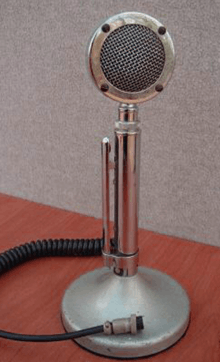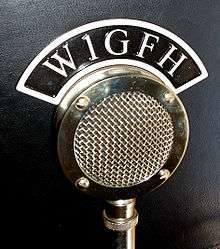Astatic Corporation
The Astatic Corporation is a commercial audio products manufacturer located in Solon, Ohio United States.

History
In 1930, two amateur radio operators, Creed M. Chorpening, W8WR (later W8MJM) and F.H. Woodworth, W8AHW began experimenting with different types of microphones for their "ham' stations. Their mutual friend, Charles Semple, worked for Brush Development Company where he had been experimenting with Rochelle salt crystals. Semple demonstrated some crystal pick-ups that Brush was working with, leading Chorpening and Woodworth to found The Astatic Microphone Laboratory, Inc. in Youngstown, Ohio in 1933. Semple was brought into the company as general manager to manufacture and market the company's model D-104 Crystal Microphone as well as other crystal microphones, crystal phonograph pickups and recording heads.[1] In 1944, Astatic moved operations to Conneaut, Ohio and supplied microphones, pickups and crystal cartridges as well as hydrophone and Sonar devices to the military during World War II.[1]
After World War II, Astatic Microphone Laboratory became The Astatic Corporation. Currently, the company is located in Solon, Ohio and offers microphones and audio accessories to various audio industries.[2] The Amateur & CB product division of Astatic was sold to DAS Companies, a major mobile communications product distributor. DAS has since expanded the Astatic name to include many accessories including coaxial cables, meters and antennas.[3] Astatic also currently manufactures bullet style microphones in a partnership with Hohner, which are extremely popular among harmonica players. The original Astatic model JT-30 is one of the most popular microphones for blues harp players. Today, the model is sold as the Hohner 1490 Blues Blaster.[4]
D-104 microphone

Introduced in 1933, the Astatic model D-104 became known for its high frequency response that contributed to better communications audio quality. Early D-104 mikes used a 1" thick case, a large ID tag, and holes for "ring & spring" mounts. The design was modified in April 1937 with smaller tags and reduced thickness. A black "grip" switch stand ("G" Stand) with a metal ID tag was manufactured in January 1938. A solid-state amplifier was incorporated into to the "G" stand in the 1960s. A US Bicentennial model D-104 was manufactured in 1976 featuring an eagle and shield design on the back plate, as well as a chrome base. There was also a gold (in color) version with the eagle on the back plate. There were other variations, but production ceased in 2001.[5] The D-104 is often used by CB radio hobbyists and vintage amateur radio enthusiasts as part of their operating activities.[6]
See also
References
- 1 2 Astatic company history (archived 2009-05-11)
- ↑ Astatic company
- ↑ "DAS Companies, Inc. -".
- ↑ "Archived copy". Archived from the original on 1 November 2013. Retrieved 2013-10-30.
- ↑ "BCMICS".
- ↑ Vintage AM radio at Dayton Archived 30 June 2007 at the Wayback Machine. (8 March 2001) American Radio Relay League
External links
![]() Media related to Astatic Corporation at Wikimedia Commons
Media related to Astatic Corporation at Wikimedia Commons